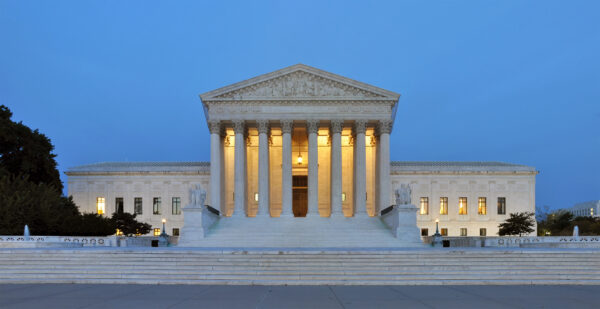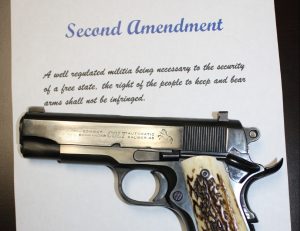
By Dave Workman
Editor-in-Chief
June 26 marks the 15th anniversary of the landmark 2008 Supreme Court ruling in District of Columbia v. Dick Anthony Heller, and it is an occasion American gun owners can celebrate because it led to two other important rulings, McDonald v. City of Chicago (2010) and New York State Rifle and Pistol Association v. Bruen (2022), both of which have given headaches to proponents of citizen disarmament.
While Heller—authored by the late Associate Justice Antonin Scalia—affirmed the individual right to keep and bear arms, and have a handgun in the home for personal protection, the later rulings expanded (many would argue restored) the Second Amendment to protect the right from municipal prohibitions and incorporate the amendment to the states via the 14th Amendment. And last year’s Bruen ruling made it clear the right to bear arms extends beyond the doorway of one’s home.
As if to underscore the establishment media’s approach to the Second Amendment, NBC News published a report last week about how lower courts have been interpreting and applying the high court’s new guidelines for determining gun rights cases.
That report noted, “The decision by the Supreme Court’s 6-3 conservative majority has led to a flurry of challenges to long-standing laws — both federal and state — and prompted some judges to find they are unlawful under the new standard. Other judges have upheld gun restrictions, creating divisions on the law across the country. It has also led to blue states passing a new wave of gun laws in the hope that they will not fall foul of the Supreme Court’s rationale.”
And just what is the “new standard?”
“The new test the Supreme Court adopted in New York State Rifle and Pistol Association v. Bruen requires judges to focus solely on whether a law comports with a historical understanding of the Second Amendment,” NBC explained.
The court ruled New York’s 100-year-old restrictive concealed carry law, mandating a “good cause” in order to get a carry license, was unconstitutional. Lost in the debate was the fact that if the law was found unconstitutional in 2022, it had always been so, and generations of New York citizens had been wrongly denied their right to bear arms. Nobody has wanted to talk about that.
Heller established several things, including the fact that the only previous notable Second Amendment ruling in the 1939 Miller case was wholly misinterpreted—and perhaps deliberately so—by gun control proponents. In his ruling, Justice Scalia noted, “JUSTICE STEVENS places overwhelming reliance upon this Court’s decision in United States v. Miller. “[H]undreds of judges,” we are told, “have relied on the view of the amendment we endorsed there,” and “[e]ven if the textual and historical arguments on both sides of the issue were evenly balanced, respect for the well-settled views of all of our predecessors on this Court, and for the rule of law itself . . . would prevent most jurists from endorsing such a dramatic upheaval in the law,” post, at 4. And what is, according to JUSTICE STEVENS, the holding of Miller that demands such obeisance? That the Second Amendment “protects the right to keep and bear arms for certain military purposes, but that it does not curtail the legislature’s power to regulate the nonmilitary use and ownership of weapons.”
“Nothing so clearly demonstrates the weakness of JUSTICE STEVENS’ case.” Scalia stated. “Miller did not hold that and cannot possibly be read to have held that.”
Yet decades of legal and political misrepresentation have truly muddied the waters regarding the Second Amendment’s true meaning, so much so that even now, years after Heller, and McDonald and Bruen, anti-gunners continue insisting the Second Amendment only applies to the militia, and to arms present when the Bill of Rights was adopted.
Yet, no Second Amendment critic has leaped to the conclusion the First Amendment only protects single-sheet news pages printed on manual presses, while not protecting television, radio and newspapers printed on huge web offset presses.
A couple of pages later in the Heller ruling, Justice Scalia made a point which seems riper for high court review than ever before: Whether so-called “assault weapons” are protected by the Second Amendment.
“We may as well consider at this point (for we will have to consider eventually) what types of weapons Miller permits. Read in isolation, Miller’s phrase ‘part of ordinary military equipment’ could mean that only those weapons useful in warfare are protected. That would be a startling reading of the opinion, since it would mean that the National Firearms Act’s restrictions on machineguns (not challenged in Miller) might be unconstitutional, machineguns being useful in warfare in 1939. We think that Miller’s ‘ordinary military equipment’ language must be read in tandem with what comes after: ‘[O]rdinarily when called for [militia] service [able-bodied] men were expected to appear bearing arms supplied by themselves and of the kind in common use at the time.’”
There are currently several legal actions underway challenging bans on modern semiautomatic rifles, which are today in common use (millions are owned by as many law-abiding citizens), and at some point—probably sooner than later—the court will take up one of these cases and make a ruling by necessity.
The gun control lobby places much importance on another of Justice Scalia’s observations: “Like most rights, the right secured by the Second Amendment is not unlimited. From Blackstone through the 19th-century cases, commentators and courts routinely explained that the right was not a right to keep and carry any weapon whatsoever in any manner whatsoever and for whatever purpose.”
Gun prohibitionists believe this allows the government to prohibit civilian ownership of certain types of firearms. This is open to interpretation, as well. It is widely accepted that people cannot carry arms in a way designed to intimidate or frighten others, nor can guns be used promiscuously for illicit purposes, such as shooting traffic lights or telephone line insulators.
But the carrying of arms in a peaceable must be protected, and Bruen appears to make that plain.
What is also plain is that so-called “safe storage” requirements now being adopted in various jurisdictions may also not stand up under constitutional scrutiny. Scalia’s opinion notes, “We must also address the District’s requirement (as applied to respondent’s handgun) that firearms in the home be rendered and kept inoperable at all times. This makes it impossible for citizens to use them for the core lawful purpose of self-defense and is hence unconstitutional.”
A firearm locked and unloaded in a safe is essentially inoperable, especially in an emergency. Gun control proponents avoid this discussion repeatedly.
And finally, Justice Scalia wrapped it up by noting, “We know of no other enumerated constitutional right whose core protection has been subjected to a freestanding “interest-balancing” approach. The very enumeration of the right takes out of the hands of government—even the Third Branch of Government—the power to decide on a case-by-case basis whether the right is really worth insisting upon. A constitutional guarantee subject to future judges’ assessments of its usefulness is no constitutional guarantee at all. Constitutional rights are enshrined with the scope they were understood to have when the people adopted them, whether or not future legislatures or (yes) even future judges think that scope too broad.
“We would not apply an “interest-balancing” approach to the prohibition of a peaceful neo-Nazi march through Skokie. See National Socialist Party of America v. Skokie, 432 U. S. 43 (1977) (per curiam). The First Amendment contains the freedom-of-speech guarantee that the people ratified, which included exceptions for obscenity, libel, and disclo sure of state secrets, but not for the expression of extremely unpopular and wrong-headed views. The Second Amendment is no different. Like the First, it is the very product of an interest-balancing by the people—which JUSTICE BREYER would now conduct for them anew. And whatever else it leaves to future evaluation, it surely elevates above all other interests the right of law-abiding, responsible citizens to use arms in defense of hearth and home.”




